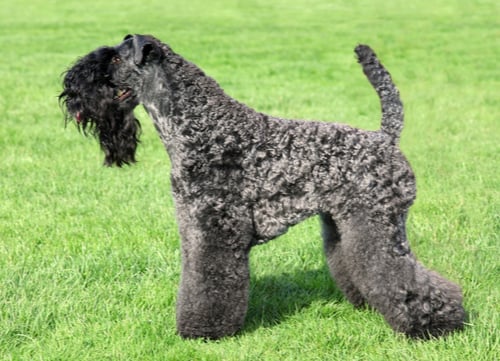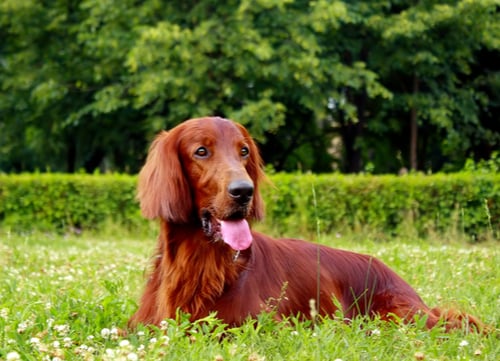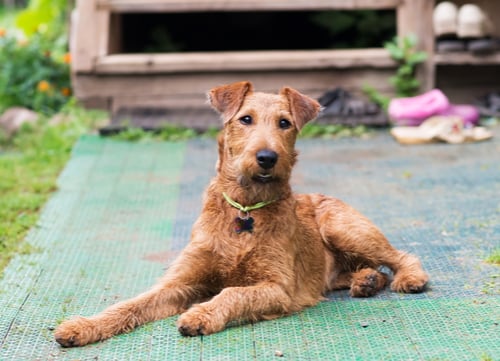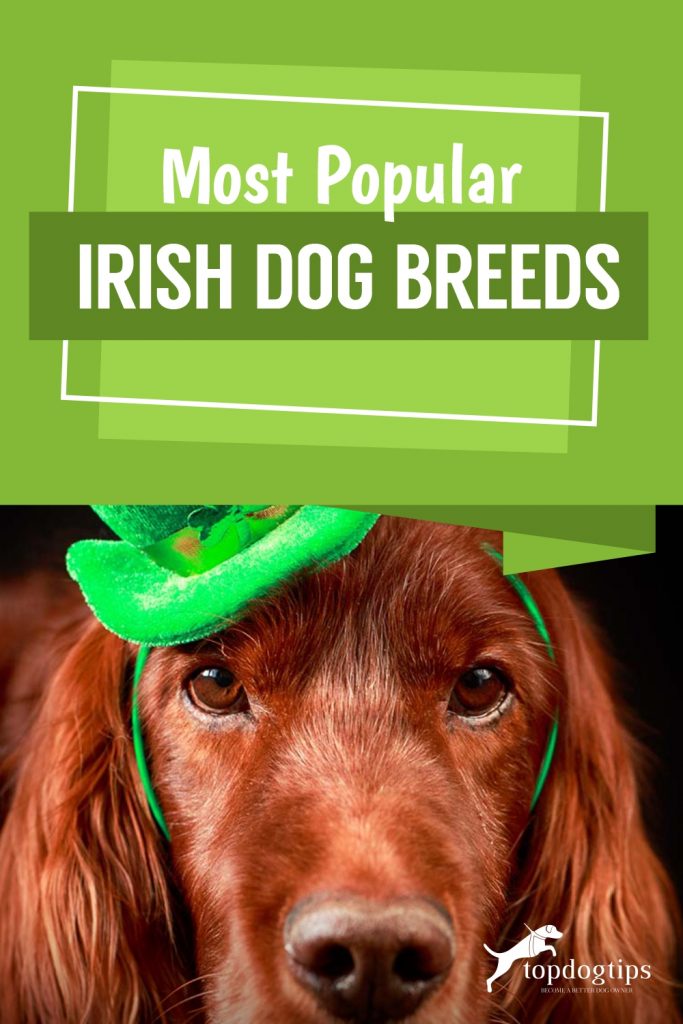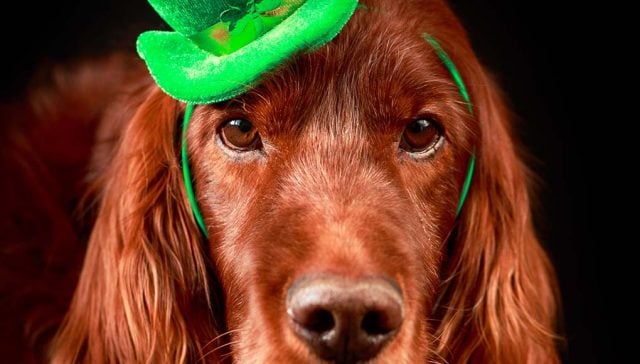
There are no docile Irish dog breeds; they are all highly intelligent and reared to outwit livestock or prey and endure the severe Irish weather.
If you are considering purchasing one of these remarkable canines and want to know more about them, you can expect to find essential information about four of the most popular Irish dog breeds below.
Irish dogs consistently rank among some of the most popular breeds in the world. They are an important part of many families, and according to research, at 24.1 million posts, they are also an integral part of our Instagram feeds!
The Irish have always been a nation of dog lovers. Irish breeds are trained for a variety of tasks such as herding cattle and sheep, or hunting games.
Some are used as guard dogs to protect against predatory animals and intruders. But they also make loving and friendly house dogs.
Here is everything you need to know about the most popular *Irish dog breeds*.
Meet the Irish: Popular Dog Breeds from Ireland
1. Kerry Blue Terrier
With its roots in County Kerry, Ireland, the Kerry Blue Terrier breed is the ideal working dog.
They were originally bred to herd cattle and sheep, kill rodents, and hunt birds and small game. They are exceptionally brave and clever and make devoted family pets.
Behavior and Temperament
The Kerry Blue Terrier is an independent, hard-working, and athletic dog. This breed has a limitless amount of energy and stamina; like most terriers, their favorite pastimes are chasing and digging, and they love to bark even if they have nothing to bark about.
If you are looking for a good belly laugh, the Kerry Blue Terrier will certainly give you one, as they are well known and loved for their outlandish personalities.
These canines are high-energy dogs, they don’t like sitting around doing nothing. They need plenty of physical exercises, and because of their high intellect, they also need a lot of mental stimulation.
You can’t leave a Kerry Blue Terrier alone for too long, they will get bored and start destroying things. You will need to train your pet well, or you will find them difficult to deal with.
Despite their loving nature, this breed does not like other dogs, and because they were originally trained to hunt small animals, they perceive them as prey and will chase them if they come into contact with them.
Grooming
The Kerry Blue Terrier has a dense, soft, and wavy coat; even though they don’t shed, they are very high maintenance.
You will need to brush their coats daily, trim the fur, and bathe them every four to six weeks. Trim their nails every two weeks and check their ears weekly for bad smells and odors, which are signs of infection.
To prevent infections, you should also wipe the ears out with a cotton ball soaked in a pH-balanced ear cleaner.
Additional Information
- Lifespan: 12 – 15 years
- Colors: Slate blue, blue & black, silver, blue, grey, black
- Weight: 33 – 40 lbs
- Height: 17 – 20 inches
- Hypoallergenic: Yes
Fun Fact: Despite its size, the Kerry Blue Terrier is capable of squeezing through the tiniest gaps.
2. Irish Setter
The Irish Setter has been around since the 18th century, it is believed to have been cross-bred with the Gordon Setters, pointers, spaniels, and English Setters.
This Irish breed was originally called ‘red spaniels’ because they were red and white in color instead of the hard dark red we see today.
Rumor has it that the Earl of Enniskillen is responsible for popularizing the solid red kind of Irish Setter we all know and love.
Behavior and Temperament
The Irish Setter is a playful and lovable dog, they don’t take themselves too seriously. They are quick to snuggle, and they are always up to some type of mischief.
You can expect your canine to rummage through your underwear drawer, find the most embarrassing pair of knickers you own, and saunter into the living room with them in their mouth when guests are around.
In other words, if you don’t want to get exposed, put your unsavory items in a place where your dog won’t be able to reach them.
This breed is a lover of people; they enjoy being the center of attention and will do whatever it takes to make sure that all eyes are on them.
Despite their jovial nature, they make powerful watchdogs and will alert you as soon as an unfamiliar face shows up.
They must be socialized early, during which time they should be exposed to a variety of experiences, sounds, sights, and people.
Grooming
The Irish Setter has a beautiful coat, and it is the color and natural sheen that has earned them its reputation as one of the most beautiful dog breeds in the world.
The fur must be brushed at least every two days to keep the coat from tangling and losing its sheen. Anytime you take your canine on a hike or out in the field, check the coat for debris and burrs.
As long as you keep your dog well-brushed, you should only need to bathe him twice a year.
However, if you are planning on showing him, it is advised that you give him additional baths. Brush your dog’s teeth daily to prevent bad breath and gum disease.
Trim the nails once or twice a month, and clean out the ears with a cotton bud and some veterinarian-approved solution once a week.
Additional Information
- Lifespan: 15 years
- Colors: Red, chestnut, mahogany
- Weight: 60 – 70 pounds
- Height: 25 – 27 inches
- Hypoallergenic: No
Fun Fact: The Irish Setter was the main character in the Walt Disney film ‘Big Red.’
3. Irish Terrier
The Irish Terrier was recognized as an Irish breed in 1875 in Glasgow, Scotland, during a dog show.
The 1880s was a triumphant decade for the Irish Terrier; they were the catalyst for change in the appearance of British dogs and led to the banning of ear cropping for any breed in the United Kingdom.
During the First World War, they received many accolades for loyalty and bravery. It is believed that the lives of many soldiers were saved because of the courageous nature of the Irish Terrier.
Behavior and Temperament
The breed was developed to be a hunter and a companion guard dog. Therefore, they are adaptable, focused, spirited, and good-tempered.
The Irish Terrier is also devoted, curious, reckless, and plucky. Despite their many admirable qualities, the Irish Terrier doesn’t like other dogs and will go into attack mode when they come into contact with them.
They need a lot of physical and mental exercise, as well as firm discipline, or their behavior will spiral out of control.
Grooming
The Irish Terrier has wiry and dense hair; they have a double coat that protects them against wet or cold weather and the rough underbrush when he’s working and playing outside.
You will need to brush the coat once a week with a natural bristle brush. Additionally, you will need to strip it by hand a couple of times each year.
Hand stripping is essential if you want to keep the bright color and hard texture or if you plan on showing your dog. Instead of trimming, it is easier to clip the coat, but it’s important to mention that clipping lightens the color of the coat and makes it softer to touch.
Additional grooming needs include nail care and dental hygiene; brush your dog’s teeth daily and trim their nails once or twice a month.
Additional Information
- Lifespan: 13 – 15 years
- Colors: Red, wheaten, red wheaten
- Weight: 25 lbs male, 27 lbs female
- Height: 18 inches
- Hypoallergenic: Yes
Fun Fact: During the First World War, Irish Terriers worked as messengers for the military.
4. Irish Water Spaniel
The Irish Water Spaniel has been a native of the Emerald – Isle since 1830. History records that the breed came from the kennel of Justin McCarthy; however, it appears that he took the secrets of how these *Irish dog breeds* came to be to the grave.
Nevertheless, rumors suggest that they may be a cross between Portuguese Waterdogs and the Poodle and Barbet-type dogs that were around during that time.
There was also another type of curly-coated Water Spaniel during that era that may have played a role in the breed’s makeup.
The Irish Water Spaniel is very sensitive to their surroundings; they want to know exactly what’s going on at all times.
Irish Water Spaniels are not fond of strangers, but the good news is they are not aggressive with them either.
In general, they are easy to train; however, they do like to think for themselves, which makes them very stubborn.
This characteristic is even more so with young males who want to prove their status. If you are a first-time dog owner, you might want to take these character traits into consideration when making your decision.
Behavior and Temperament
Dog lovers seek out the Irish Water Spaniel for its superior hunting and water skills. They are fanatical about pleasing their owners, and they make devoted companions.
These canines are also excellent watchdogs if they are socialized properly from an early age.
The Irish Water Spaniel is a hunting breed with plenty of energy and stamina. For this reason, they do not do well in apartments and will need a yard to run around in. Your dog will need at least one hour a day to go on a hike, a long walk, or a run.
Playing ball is always a great way to keep him active. They also enjoy swimming, and their webbed feet make them extremely good at it.
So, if you have access to a swimming pool or a lake, you can add that to your list of workouts. Don’t be surprised when your dog takes off running and goes for a swim if there is a lake nearby.
It will take a fair amount of training to get him not to do this. So, if you don’t want to deal with trying to get him out of the water, it's best that you keep your pet on a leash until you are confident that he won’t dash and splash.
If it isn’t possible to take your dog out for a full hour at once, you can break the time up into three 20-minute sessions per day.
Despite the gracious nature of the Irish Water Spaniel, they love playing games, and they are well known for their mischievous behavior.
They are very creative when it comes to finding ways to entertain themselves, and they are known to make games out of everyday regular tasks. As long as your pet has toys around, he will never be bored by himself.
Grooming
These *Irish dog breeds* have a double coat, a top and a bottom layer. They don’t shed a lot of hair, but you will still need to brush them two to three times per week to prevent matting or tangling.
The coat's natural oils attract dirt and debris, so you will need to be extra attentive to this. Because of their floppy ears, they hold on to moisture; this warm, wet environment is the perfect breeding ground for bacteria.
Therefore, make sure you clean and dry your dog's ears each time you take him swimming. Brush their teeth once a day and cut their nails once or twice a month, depending on how quickly they grow.
Additional Information
- Lifespan: 12 – 13 years
- Colors: Solid liver
- Weight: 45 – 58 pounds female, 55 – 68 pounds male
- Height: 21 – 23 inches female, 22 – 24 inches males
- Hypoallergenic: Yes
Fun Fact: Irish Water Spaniels are referred to as the ‘clowns’ of the spaniel family, not just because they are funny, but also because their curly hair creates a prominent poof on top of their head.
Irish Dog Breeds: Final Thoughts
Although the Irish Water Spaniel is a popular breed to have in the home, they are difficult to find and, therefore, expensive to buy.
Because of their high price tag, a lot of illegal breeding takes place. A word of caution: before you hand over any money, do the right checks to ensure you are purchasing from a legitimate breeder.



